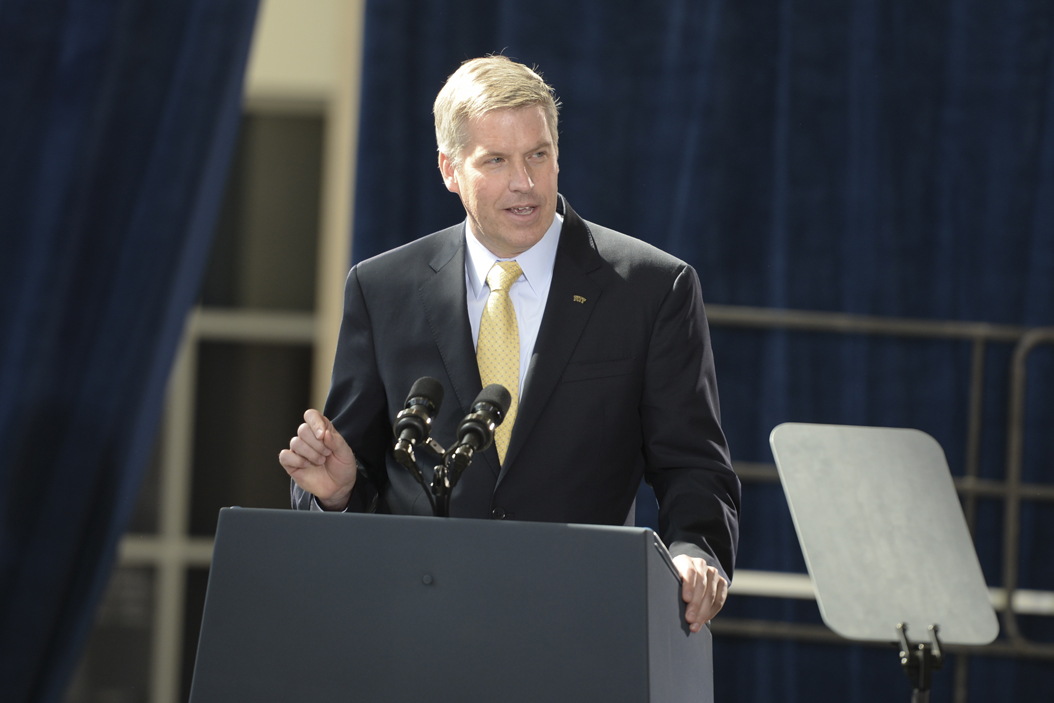Pitt planning for budget cuts for 2017-18 fiscal year


Chancellor Patrick Gallagher might potentially have to face a budget cut for the 2017-18 fiscal year. Kate Koenig | Senior Staff Photographer
Even with a $3.6 billion endowment, possible budget changes from Harrisburg could mean Pitt will have to find other funding sources in the 2017-2018 fiscal year.
The University uses funds from the state for teaching instruction, financial aid, student services like the wellness center and the Student Organization Resource Center, maintenance and facilities costs and administrative support. Last year, Pitt received $146.77 million from the state.
This year, Pitt requested $154.11 million from the state government, which is $7.34 million more than what it received last year. But the current state of Pennsylvania’s finances — with a projected $603.8 million deficit approaching — means that there could be budget cuts.
“A state cut is something we’re actually going to have to contemplate,” a recent University Times report quoted Chancellor Gallagher as saying to the University’s Senate Council Dec. 14.
Though the state estimates a deficit for the 2016-2017 fiscal year, Marc Stier, the director of the Pennsylvania Budget and Policy Center said in a statement that it could grow before the summer.
“Between the current year and next year, the [state] General Assembly may need to close a budget gap that approaches $3 billion by June 30,” he said. “And, as mandated costs grow faster than revenues, budget deficits in future years will approach that number as well.”
According to the November Pennsylvania Department of Revenue monthly report, the state’s total revenue for the 2016-17 fiscal year — made from collections such as tax revenue — currently sits at $10.8 billion. That number is about $261.8 million, or 2.4 percent, below where it should be.
Despite the disparity, state officials are remaining publicly optimistic about budget cuts. In a mid-year budget briefing, Budget Secretary Randy Albright said, “We will exhaust any and all opportunities to restrain or reduce state spending before seeking additional revenues necessary to balance the 2017-18 budget.”
Since the budget is not approved officially, it’s not clear how exactly a budget cut would affect students, according to University officials.
“It is too early in the Commonwealth budget process for the University to begin running scenarios on the University’s budget for the year beginning July 1, 2017,” Senior Vice Chancellor Chief Financial Officer Arthur G. Ramicone said in an email.
In the 2016-2017 fiscal year, Gov. Tom Wolf allocated $1,628,496 billion for higher education out of the $31,533,732 billion general fund budget. He is set to present his 2017-2018 budget proposal on Feb. 7.
Of Pitt’s revenue, 44 percent comes from the University’s general fund — which consists of money from tuition, state funding and investment income — with state funding making up seven percent of Pitt’s entire budget, as The Pitt News has reported previously.
The remaining 56 percent of Pitt’s revenue comes from gifts, research, the School of Medicine Division and auxiliaries like student housing, food services and bookstores.
In the past, when faced with a smaller budget, the University has made cost-cutting efforts like moving the administration of the College of General Studies into the School of Arts and Sciences, redesigning the university post-retirement medical benefits program and electronically distributing departmental budget reports, student bills, and paychecks, according to the University’s 2016 cost containment page.
In an email statement about the budget’s effect on students, financial aid and university life, spokesperson Joe Miksch said, “We can’t predict the exact level of impact … but the University will continue to work with the governor and legislature on this matter.”
Although the University won’t know the state budget until after February, they are preparing for a budget cut by taking precaution ahead of time.
“We will be factoring some of this into the [University] planning and budgeting committee to be appropriately conservative this year as we look at our planning horizon,” Gallagher said to the University Times.
Editor’s note: a previous version of this story reported that state funding makes up 15 percent of Pitt’s entire budget. This is not correct. State funding makes up seven percent of Pitt’s budget. This has been corrected. The Pitt News regrets this error.
Recent Posts
Therese Pitman: Giving back to Pitt’s student-athletes with equality
Pitman is Pitt’s Director of Student Athlete Development where she helps student-athletes navigate their career…
Pitt speech and debate team heads to nationals
The William Pitt Debating Union, Pitt’s speech and debate team, sends students to both in-person…
Visuals: A Year in Review
The visuals desk had an interesting year. In the midst of the 2024 Presidential Election,…
De-stress events across campus offer students a break from studying
During finals week, departments across campus are offering wellness events to help students manage stress…
Pitt students share their summer plans
After a long and strenuous academic year, many students are excited to take a break.…
Column | Collaboration and connection make us better — yes, even in journalism
Today is the last day I will ever do this, and despite the amount of…

